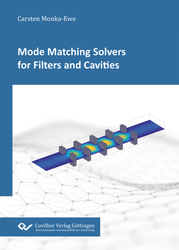| Fachbereiche | |
|---|---|
| Buchreihen (96) |
1378
|
| Nachhaltigkeit |
3
|
| Gesundheitswesen |
1
|
| Geisteswissenschaften |
2363
|
| Naturwissenschaften |
5406
|
| Ingenieurwissenschaften |
1791
|
| Allgemeine Ingenieurwissenschaften | 292 |
| Maschinenbau und Verfahrenstechnik | 861 |
| Elektrotechnik | 686 |
| Bergbau- und Hüttenwesen | 30 |
| Architektur und Bauwesen | 75 |
| Allgemein |
98
|
|
Leitlinien Unfallchirurgie
5. Auflage bestellen |
|
Erweiterte Suche
Mode Matching Solvers for Filters and Cavities
Carsten Monka-Ewe (Autor)Vorschau
Leseprobe, PDF (830 KB)
Inhaltsverzeichnis, PDF (700 KB)
Over the past decades computational electromagnetics tools have become an indispensable aid for engineers and scientists. Partial Differential Equation techniques, with the Finite Element method being an example, are recognised as being the standard approach for the electromagnetic analysis of closed structures such as waveguide components and cavities.
A major drawback of these techniques results from the fact that they require a spacesegmentation of the domain under consideration. If complex geometries or structures with dimensions exceeding few wavelengths are to be solved, the resulting meshes tend to become very large, which is undesirable in terms of memory requirements and computation time.
In contrast, a striking feature of the Mode Matching technique discussed in this thesis is its ability to efficiently solve the field problem imposed by such structures, provided they can be decomposed into sub-domains whose spectrum of Eigenmodes is known analytically.
Using the Mode Matching technique, orthogonal expansion of the yet unknown tangential fields at the interfaces between these sub-domains is performed, which leads to a system of equations that can be solved for the Eigenmodes‘ amplitudes.
Several applications such as waveguide filter design strongly benefit from the Mode Matching technique‘s computational efficiency rather than they suffer from the geometric limitations resulting from the method‘s quasi-analytical approach.
The present thesis provides a complete treatise of the Mode Matching technique. While literature has focused almost exclusively on the method‘s underlying electromagnetic concept, this work offers in-depth insights into implementation-related aspects such as efficient matrix population and proper scattering parameter calculation.
To illustrate the advantages of the Mode Matching technique, the solvers developed in the scope of this thesis are used to analyse problems from two fields of application:
The analysis of waveguide filters represents the first application studied in this thesis: Various filter structures have been investigated using the newly developed solvers. Both the simulation methodology as well as the obtained results are discussed with a special focus on the close interplay between filter design and full-wave analysis of waveguide filters.
Moreover, the analysis of partially filled coaxial waveguides, which may be included in tubular filters to increase the power handling capability, is another focus of this work.
The second application of the Mode Matching technique examined in this thesis is the analysis of electromagnetic cavities used for cavity perturbation material measurements. This thesis presents a concise outline of the cavity perturbation material measurement technique and contributes a rigorous analysis of „secondary effects“ afflicting this method.
To illustrate the superiority of the Mode Matching technique, a performance comparison between the Mode Matching solvers developed in the scope of this thesis and a commercial Finite Element tool was conducted. The findings from this comparison illustrate for suitable structures that Mode Matching by far outperforms the commercial Finite Element implementation in terms of computation time and accuracy.
| ISBN-13 (Printausgabe) | 9783736970861 |
| ISBN-13 (E-Book) | 9783736960862 |
| Buchendformat | A5 |
| Sprache | Englisch |
| Seitenanzahl | 270 |
| Umschlagkaschierung | glänzend |
| Auflage | 1. |
| Erscheinungsort | Göttingen |
| Promotionsort | Braunschweig |
| Erscheinungsdatum | 22.10.2019 |
| Allgemeine Einordnung | Dissertation |
| Fachbereiche |
Elektrotechnik
Nachrichten- und Kommunikationstechnik |
| Schlagwörter | Electromagnetics, Computational Electromagnetics, Waveguides, Rectangular Waveguides, Circular Waveguides, Coaxial Waveguides, Partially Filled Waveguides, Eigenmodes, Eigenwaves, Mode Matching, Eigenwave Expansion, Eigenmode Expansion, Waveguide Discontinuities, Scattering Parameters, Filters, Direct-coupled Filters, Filter Design, Filter Optimisation, Microwave Filters, Waveguide Filters, Tubular Filters, Impedance Inverters, Microwave Resonators, Cavities, Cavity Perturbation, Q Factor, Q Factor Measurements, Material Characterisation, Permittivity, Loss Tangent, Water, PTFE, Teflon |
| URL zu externer Homepage | https://www.tu-braunschweig.de/ihf/allgemein/mitarbeiter/liste/carstenmonka |








